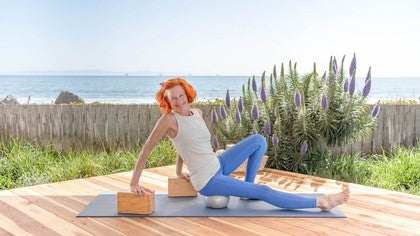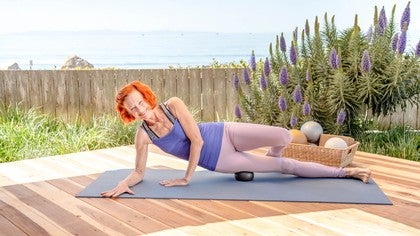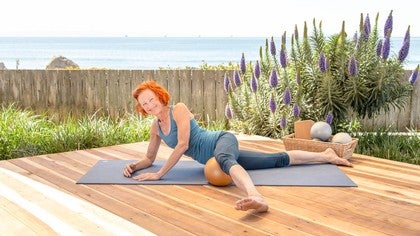Description
Props Needed: Silver Yamuna USA® Ball or 5" Ball, 2 Yoga Blocks
About This Video
Transcript
Read Full Transcript
Our next class will be for the hamstrings. And so many people have tight hamstrings and they have a compounding effect on our whole physiology. Again, coming back to the way we sit the fact that we just sit a lot and most people sit not at the top of the sit bones, but they slouch backwards and guess what happens? These muscles start to get very tight. They become chronically tight and they start to pull your back down and they don't weight bear again.
So if you look at old people, sometime they kind of shuffling forward. I'm not saying our community is of that nature, but we want these muscles nice and long and able to bear weight. They're also very key for bending and moving the leg backwards when we walk or we run. And when we bend down to be able to hip hinge. If these muscles are tight and they're locked into our pelvis, then over time, we only bending from our back and it's creating a chain reaction of dysfunction in the body that it has to resolve.
So we want long hamstrings. We want to have this whole back chain of the body fired up. It gives so much freedom of movement and to do it, we're going to roll out all the connective tissue. So let's come down to the floor. So the first part of this routine will be about actually separating our glutes from the hamstrings.
Remember, the bottom can be tucked under, these muscles can drape down and they all kind of get stuck together. And then again, we've got this dysfunction of muscle groups, less potential. So we are looking to lift the glutes back up and start to lift the hamstrings up. And for this first part, I'm going to work with a black ball or a smaller harder ball. And the first part will be finding your sit bone, that little knobbly bone at the bottom of the pelvis and getting on top of it.
So you're nice and pressing straight down into the ball and finding that pressure 'cause we're looking to get the bone to start to spread all the muscles around it. From here, I like to say I'm at the top of the mountain and I'm going to start rolling my bottom forward and grabbing all of that glute muscle and lifting it up. So I'm tractioning it up a little bit. And I literally can start to feel the hamstring muscle being stretched in our position. And then rolling up again and now rolling down hill again into the valley in front.
This is where the tendons start to connect in with that sit bone and they can be kind of sensitive. So we'll do this a few times just nice and slow, lifting your butt, rolling downhill, separating out this whole shaft of the muscle at the back and then rolling forward. So loosening up all the association and all the connections. Those sit bones have so many different muscle groups connected and ending there. It's like from our back, from our legs, from the sides of the pelvis, a lot is going on in that sit bone area.
And going back, now we're going to go side to side, again, widening out all of those muscles. So sitting right at the top and the first movement I'm going out and I'm rolling the sit bone, in my case, to the right, so I'm grabbing all of that tissue. You can even lean into it, to widen and separate those muscles out. It can affect the side of the hamstrings quite extensively, starting to open them up and then going inwards towards the midline of the body. Again, rolling up and out, pressing that tissue away, and rolling in.
Now, when you're doing this yourself, take your time. You may find that there's a spot that's so tight or so calcified, that you want to spend a bit more time. And if you feel the tension and the tightness, please do go back and visit it in your own rhythm and your own time 'cause some of these muscles take two minutes, five minutes, 10 minutes to really release. Come back to the middle and now double check the leg that's in front, 'cause we have all sorts of patterns, but we're looking to train the bones back towards a straight line so check that your knee's going straight up, your foot's in front of you so if you lined yourself up, you're straight and now we're going to circle around the bone, so I'm going downhill, my bottom went backwards and I'm start circling out and around that bone. I'm going nice and slow, but, there may be areas that are tight.
There's a lot of muscles that become tendons and then connecting to the bone here so you may find chord like feelings, which can be tendons that have lost their resiliency and their elasticity and we want to kind of wake them up, elasticate them again, release the connection between the muscle and the bone, so they're more functional. Reverse your circles the other way, loosening this whole area up, making sure that it's starting to be a lot more free so every muscle can work as itself. And now roll backwards with your bottom so you're going downhill into this valley area, which is called the tendon, the hamstring tendon and, or the glute fold. This is kind of where your glutes end and your hamstring muscle generally speaking starts. It can be a very tender area, a very tight area.
Many times, people have a hard time being in this area 'cause their hamstrings are tight and it's really crunchy and difficult to be like this. So you can use a block, two blocks, a book, anything to be able to be into this area and feel capable. Now, because the hamstrings are tight, it's very often that the back slouches and I would rather invite you to even lean back a bit and then see, do you notice how I'm taking my pelvis and creating more of a lift in my sacrum? And what this does, is it starts to really open up the hamstrings. So now, you should be getting a nice stretch right in the area where the muscle can be really tight and normally pull down.
You want to find that spot, if you can. If you need to lean back more, do so, whatever you need to do, go for it. And then from here, we're going to roll a little bit side to side, just a little bit. You'll feel accordion like, or I shouldn't say accordion like, I should say string like feelings and going from side to side, to loosen up the shaft of the muscle and you'll feel a twang, twang, twang, over those tendons and textures. So then come back right to the middle.
See if you can get this nice lift and we're going to shift into a higher ball now. So I'm coming down. Again, you do not have to change. I'm just showing variations so you have choices and I'm taking the silver ball that I think it's about six inches, six and a half inches, a taller ball because it gives more lift. Now notice the leg isn't as high, so it's easier to get this angle.
And for most people, there's a lot of tightness in the hamstrings. So take a deep breath in here, lift up, and then see if you can sink into this muscle, even soften your knee a little bit and then press down to see if you can get the bowel to sink a little bit deeper. Again, big breath, and then sink down and you should start to really find the patterns. You can also have the outer part of the hamstring, very, very tight, and maybe the inside less tight. Those, the bands of that muscle can, as they shorten, I'm rolling down a little bit more, they can start to pull.
One side could be more dominant than the other. And then they can pull the kneecap out, they can pull the hip and jam the hip, they can do a bunch of things that throw the leg out of alignment and then you're fighting a structure that doesn't work as well. Big breath in, sink down. Another variation, soften the knee, so my hip is dropping down and then pressing down attempting to find that place where you're sinking into the muscle. One more time, sinking down.
This is looking very effective in my body. It feels right. And then I'm going to roll further back. Now think of it this way, if I had a client, I would be having my hands on either side of the thigh, pressing down into the ball to help them really get that release. It can be so effective.
So you want to figure ways that you can do it. Maybe being on a smaller ball, closer to the ground works. And I'm very slowly moving from side to side, but most important, I'm not letting my knee roll from side to side 'cause that ends up in different muscle groups. So we want to be right in that central shaft of the hamstring. Now I'm going to drop my bottom down and again, press into the ball.
Now I can actually start to use my hand to really get that tractioning and sinking quality to stretch the fibers of the muscle out. Then I'm lifting again, rolling further back. So now it's about two thirds and then sinking down. Watch that you're not collapsing in your lower back. To the best of your ability, lift your back up so you can get that pressure in.
If the bigger ball is too much for you, change to a smaller ball so you can get that pressure in. And most importantly, keep checking your knee and your hip that you're not off at an angle, you're not rotated in a way that you're missing the real texture of the muscle. So nicely pressing in. If the ball is lower down, you can also start to fan the leg a little bit from right to left, really feeling into the different places in the muscle, making sure that you're getting into it. Remember you have your spots.
For example, the inner part of my hamstring is more tight. So I know I want to stay here a little bit longer. And those strings of muscles connecting around the knee to give it stability, they hold the knee straight. When they're out of balance, they can pull the joint out, they could create different patterns in the knee that are less than optimal so we want to encourage this optimal alignment. Now roll down one more time so you get quite close to where the knee will be have it's bend.
So it's more towards the bottom of this chain of muscles. They will connect further down into the calf, but we're only moving to this point today. Again, roll out any area that feels tight so you're creating a breadth and a width to the muscle. Check your back. You can press into the muscle and lift the sacrum, again, to create this long band.
Remember, the sit bone should be moving away from the knee to traction the muscle out. And if you actually lifted and pull the hamstring backward, you will feel that very nicely. And now we have a fun journey back up to our sit bones. So good pressure into the knee or into the ball, I'm sorry. You can be doing this on any ball that you're working with.
The choice is yours. And very slowly press into that ball and roll out that hamstring. The harder the ball is, the more reaction you will have in the muscle. So there is a right size and a right texture for each of us. Keep rolling through right here.
I know there's a section of my hamstring that's really tight, and I can feel it now giving up the fight. Rolling through. Keep rolling on through. Remember we're going on top of the sit bone, right at the end here to lift away the glutes from the hamstring. So right as we get up here, double check again, can you get the hamstring to get even longer by breaking up the connection of the pelvis to the hamstring?
You can be as far away as you like, if you can't get it there yet, you will if you keep releasing and then roll up onto the tip of that bone and lift as you roll downhill. Just roll, roll, roll, roll, roll, roll, roll, roll, roll. So you give a little bit of upward movement in the glutes and just for a minute sit. First of all, is it easier to sit straight? That's when the hamstring is long.
Is the leg lower to the ground? And just for fun, is it easier to bend forward from the hips? Can you feel the muscle lengthening out? Which is what we're going for. So we are going to go to the other side now.
So I'm turning around. And just to show you the various impacts of the balls can have, I'm going to do the glute lifting at the beginning with a bigger ball. The pluses of the bigger ball, is it's broader, it covers more space, but it's further away from the ground so some people find that tricky to maneuver. So each ball has its plus and its minuses. Very often at the beginning, if you've had hamstring injuries, or torn muscles, or really delicate structures, or you've gone through some kind of surgery, you work with a bigger, softer ball so it's not so focused in.
As you get more specific and more savvy to your body, you go into smaller balls and harder textures. So there is a right texture for each of us. So, up on the sit bone, attempting to get straight down, attempting to get pressure into the ball. So let's take a moment and take a big breath in and then imagine pressing down. Don't just imagine, literally see, can you get the pressure of the bone into the ball?
It's very stimulating on the bone. It kind of wakes it up and gets it activated again. Again, breathing in, breathing out, pressing down into the bone, waking it up. Bones can get kind of jammed and stuck, and then they lose their life force. So this brings something back into your skeletal system.
One more time, a bone should be strong, but elastic, they're not supposed to be, when they brittle and dry, guess what, they break more easily. So here we go. We're going to start lifting the glute up, riding down and lifting the glute, pushing the flesh of the glute up, feeling that sit bone go down and then coming forward and into the tendon, or the glute fold. And back again, lifting your bottom up. Finding those spots that you feel you need to stimulate.
Fun story, I worked with a runner and we spent about a week loosening up his leg muscles, especially his hamstrings. He was very, very tight. When he would bend forward, his hands would get about to the height of his knees. Five days in, a week in, he told me he went running this morning, he broke his personal record because he'd freed up so much of the hamstring his legs were so much more powerful and they could move faster. And just, he said it was an easy run.
He couldn't believe his time. So that was of course, very delightful to hear. This work doesn't feel like you're doing any work or any exercise, it's almost counter-intuitive to do this when you want to work out, but you get a Cadillac instead of a jalopy out of your body. It removes the reasons you are having trouble. Now I'm rolling out.
I'm grabbing all the flesh off of that sit bone and dragging it out. We're making our skeleton wide and then rolling to the inside of the sit bone, widening my sit bones, literally. So going towards the midline, rolling out. And rolling in. One more time, rolling out.
Sinking into this side, you could spend quite a bit of time in each one of these points. If you can feel that the muscle is hard and tight and just like nothing's happening, take a little time there. Now start rolling around the ball, around your sit bone, roll the ball around your sit bone, spreading the muscles away from this point and widening it out. Again, you may feel this pulling into very interesting areas. You may find that you're doing a movement in one area and you feel your back reacting, or your calf and knee reacting, because the connective tissue and the fascia is one webbing.
It's connecting around everything in the body. So it has a harmonic reaction into other places. And do the reverse. So very often there can be problems in the knee and the ankle, and you relieve all around the pelvis and the hamstring, and suddenly the other areas became more free flowing and loose and strong and functional because the actual root was somewhere else. Now come up to the center, you can have your knees bent.
You can have your leg straight. See if you can get that high position on the sit bone, check the line of the leg. If you need to lean back at the hip to lift a little bit, so try to avoid falling down. And can you already begin to feel your hamstring getting longer? And now roll into the glute fold, into that tendon, right where your bottom is ending and the hamstring starts.
Just hanging out here, is going to give you, it's like it sends a message out to the whole muscle to start to release. So sinking into it, lengthening the back out, roll a little bit out, then roll a little bit in, going over those strings and feeling there, it's hamstrings, the strings of the ham, you could say, and you will start to connect in. If there's an area that's tight, an area that's really pulling, spend more time there. And rolling further back. I'm starting to press more deeply into the muscle.
I can feel the muscle releasing down towards the bone. If you really want to get into it, you could lean forward, but not many people have this flexibility to get into the muscle this way. My leg wants to roll out. So I know for a fact that I have a pattern of the outside of the hamstrings being very tight, but the middle is a little bit less so I don't want to let myself indulge in that. I want to make sure I'm really lengthening the tight part so that the leg eventually will hang more even.
So just watch your own anatomy, check that your leg, the bones are stacking up straight. You may see some very funny shapes coming in, but they are coming in to be talked to and addressed. Moving further back. Keeping this length. I'm going to start now dropping my hip and pressing in to the ball.
Dropping my hip, and pressing into the ball. Checking all the time that the hinge between the hip and the knee and the foot are going as straight as my anatomy will allow me to. Again, going a little bit right and left. Finding those spots. And now from here, two thirds of the way back.
Lowering down, and now I will start the fanning movement from side to side. If I was working with a harder ball, the pressure would be more intense. As I said, usually I will start beginners with a texture like this ball because their body welcomes the sensation and starts to let go. If you put a person, a part of your body into an experience where it's too intense, the body fights it and hardens up against it and we don't want that. We want the body to release.
We want it to be an experience that it receives that kind of locks into your brain that says, this is enhancement, this is good, I want more of this. If you set that program in motion, you will start to be hungry for this work. And literally your body will tell you where it needs to be released. Moving a little bit further down. I'm pressing in a few times.
And again, softening the knee. And rolling back and forth. Very often you can see leg alignment really change. Maybe somebody has knock knees or bowlegged, I'm not saying you can fully resolve that, but you can kind of get into the patterning to a certain extent, the soft tissue part. There may be a lot of tightness on this side that's creating the knee to go, the femur and the tibia to go in a certain way.
Now, I'm dropping the leg down and another way you may be able to get into it is to use your other leg, in some manner to press down. I'm just showing different ways. You can be very creative with this. You do not have to be following one formula. I've studied with a lot of different teachers and looked into this work 'cause it's such a game changer and there's different theories how to approach it.
So, I believe that if you listen to your body and you'll use a lot of your own intuition, you learn the basic patterns, you'll find that you will figure yourself out. So I'm beginning to roll back, moving back up. I've stayed on the gray ball this time, I can push in much deeper, rolling through that hamstring, coming all the way back up to that glute fold, taking a moment, I can sink in a heck of a lot deeper now. The leg is much longer, lifting up nicely. So you want to get to the top and I just realized I didn't just lift my butt off my hamstrings, but I actually dropped my mic as well.
You want to let go of all extraneous elements, but I'm picking this one up again. So here you are, back up to the top, all intact with the right body parts, and then see again, get that whole fleshy part of your pelvis to lift and take your time coming down. You're going to feel that whole final shaft of the hamstring being lengthened. All the way up, all the way up, all the way up, all the way up. Really roll that glute away from the hamstring.
And take a moment. Sit, check your legs out. See what they feel like. Do they feel closer to the ground? I forgot to ask you to measure or observe if one leg was longer than the other at the midpoint, because very often when the hamstring is lengthened out, I've seen people with a half inch difference in leg length, but by the time both legs are lengthened out, they've evened out again.
And you may have a super, super tight part of your body. Maybe your left hamstring is much tighter than the right side, so you need to roll it out four times in relation to the right side. So that's what I mean by be creative, notice if your body needs more attention on one side, give it that attention. Check to see, if you find it easier to bend forward. Is there more release happening in here?
And let's see what it's like to stand up. So check, always check this hinge joint. Squatting is so basic and primitive, an essential position. Most modern people can't do this at all, but just see if you can, just for fun and standing. Is it easier for you to be with your weight closer to the heels?
Are you still slung forward? In fact, you can literally feel. Inactive, totally active. Taking, lifting the glutes, holding the back part of the body. Remember, we should be having a buoyancy against gravity operating for us rather than collapsing down into gravity and just take a few steps.
See if the legs feel looser, more flexible, less efforty, lighter. Do you have a sense of a rebound and a spring to your legs and your lower body? I hope you do. That's the intention and the direction we were going with all this work. It should help your Pilates.
It should help everything you do in life. Getting the tension out, unrolling and releasing your fascia and just bringing your muscle tone back to where it should be. You will train and you will live better. Please share your comments and what this routine was like for you.
Release Your Fascia: with Niedra Gabriel
Comments
You need to be a subscriber to post a comment.
Please Log In or Create an Account to start your free trial.





















